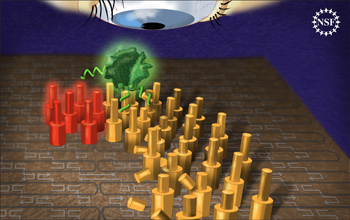The nanites are here, and they're made of DNA. Well, not really, but researchers at 4 institutions across the country have created and programmed DNA spider-bots that walk independently across a a nano-scale track. A baby step (spider step?), but also a milestone, in the nascent fields of molecular computing and and robotics. Eric Drexler had long envisioned molecular robots in his seminal book Engines of Creation, now manifesting into reality.
Normally, a robot would have a set of instructions to follow specific tasks repeatedly, from vacuuming carpets to welding cars, but programming biomolecules? Not a simple task, and requires researchers from many disciplines (CS, chemistry, engineering, biology) to collaborate, which did occur. The result are DNA walkers with 'legs' that allow them to briefly walk autonomously on a fabricated 2D landscape. They can begin and continue walking, turn, then stop. Rinse and repeat. The walkers are only ~ 4 nm in diameter, and walk very slowly, covering 100 nm in 30 minutes to an hour by only 100 steps. Compare that to previous walkers took that long to walk only 3 nm.
This shows high promise for the emerging nanomedicine field, which promises localized cancer treatment. Imagine a time when we can look back and consider chemotherapy to be barbaric and inhumane. Nanomedicine could be our ticket to that future.
Normally, a robot would have a set of instructions to follow specific tasks repeatedly, from vacuuming carpets to welding cars, but programming biomolecules? Not a simple task, and requires researchers from many disciplines (CS, chemistry, engineering, biology) to collaborate, which did occur. The result are DNA walkers with 'legs' that allow them to briefly walk autonomously on a fabricated 2D landscape. They can begin and continue walking, turn, then stop. Rinse and repeat. The walkers are only ~ 4 nm in diameter, and walk very slowly, covering 100 nm in 30 minutes to an hour by only 100 steps. Compare that to previous walkers took that long to walk only 3 nm.
This shows high promise for the emerging nanomedicine field, which promises localized cancer treatment. Imagine a time when we can look back and consider chemotherapy to be barbaric and inhumane. Nanomedicine could be our ticket to that future.

No comments:
Post a Comment